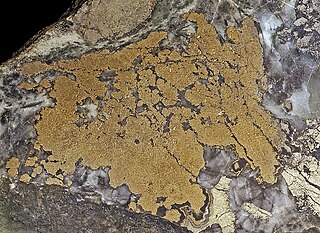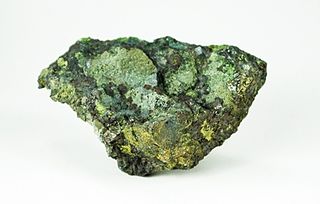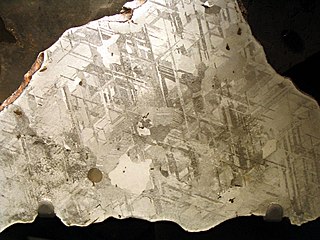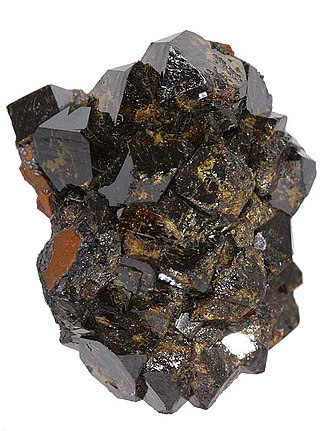
Bornite, also known as peacock ore, is a sulfide mineral with chemical composition Cu5FeS4 that crystallizes in the orthorhombic system (pseudo-cubic).

Nickeline or niccolite is a mineral consisting primarily of nickel arsenide (NiAs). The naturally-occurring mineral contains roughly 43.9% nickel and 56.1% arsenic by mass, but composition of the mineral may vary slightly.

Auricupride is a natural alloy that combines copper and gold. Its chemical formula is Cu3Au. The alloy crystallizes in the cubic crystal system in the L12 structure type and occurs as malleable grains or platey masses. It is an opaque yellow with a reddish tint. It has a hardness of 3.5 and a specific gravity of 11.5.

Ullmannite is a nickel antimony sulfide mineral with formula: NiSbS. Considerable substitution occurs with cobalt and iron in the nickel site along with bismuth and arsenic in the antimony site. A solid solution series exists with the high cobalt willyamite.

Erythrite or red cobalt is a secondary hydrated cobalt arsenate mineral with the formula Co
3(AsO
4)
2•8H
2O. Erythrite and annabergite, chemical formula Ni
3(AsO
4)
2•8H
2O, or nickel arsenate form a complete series with the general formula (Co,Ni)
3(AsO
4)
2•8H
2O.

The mineral marcasite, sometimes called “white iron pyrite”, is iron sulfide (FeS2) with orthorhombic crystal structure. It is physically and crystallographically distinct from pyrite, which is iron sulfide with cubic crystal structure. Both structures contain the disulfide S22− ion, having a short bonding distance between the sulfur atoms. The structures differ in how these di-anions are arranged around the Fe2+ cations. Marcasite is lighter and more brittle than pyrite. Specimens of marcasite often crumble and break up due to the unstable crystal structure.

Tausonite is the rare naturally occurring mineral form of strontium titanate: chemical formula: SrTiO3. It occurs as red to orange brown cubic crystals and crystal masses.

Trevorite is a rare nickel iron oxide mineral belonging to the spinel group. It has the chemical formula NiFe3+2O4. It is a black mineral with the typical spinel properties of crystallising in the cubic system, black streaked, infusible and insoluble in most acids.

Sperrylite is a platinum arsenide mineral with the chemical formula PtAs2 and is an opaque metallic tin white mineral which crystallizes in the isometric system with the pyrite group structure. It forms cubic, octahedral or pyritohedral crystals in addition to massive and reniform habits. It has a Mohs hardness of 6 - 7 and a very high specific gravity of 10.6.

Aerugite is a rare complex nickel arsenate mineral with a variably reported formula: Ni9(AsO4)2AsO6. It forms green to deep blue-green trigonal crystals. It has a Mohs hardness of 4 and a specific gravity of 5.85 to 5.95.

Taenite is a mineral found naturally on Earth mostly in iron meteorites. It is an alloy of iron and nickel, with a chemical formula of Fe,Ni and nickel proportions of 20% up to 65%.

Breithauptite is a nickel antimonide mineral with the simple formula NiSb. Breithauptite is a metallic opaque copper-red mineral crystallizing in the hexagonal - dihexagonal dipyramidal crystal system. It is typically massive to reniform in habit, but is observed as tabular crystals. It has a Mohs hardness of 3.5 to 4 and a specific gravity of 8.23.

Chlorargyrite is the mineral form of silver chloride (AgCl). Chlorargyrite occurs as a secondary mineral phase in the oxidation of silver mineral deposits. It crystallizes in the isometric - hexoctahedral crystal class. Typically massive to columnar in occurrence it also has been found as colorless to variably yellow cubic crystals. The color changes to brown or purple on exposure to light. It is quite soft with a Mohs hardness of 1 to 2 and dense with a specific gravity of 5.55. It is also known as cerargyrite and, when weathered by desert air, as horn silver. Bromian chlorargyrite is also common. Chlorargyrite is water-insoluble.

Spherocobaltite or sphaerocobaltite is a cobalt carbonate mineral with chemical composition CoCO3. In its (rare) pure form, it is typically a rose-red color, but impure specimens can be shades of pink to pale brown. It crystallizes in the trigonal crystal system.

Alabandite or alabandine is a rarely occurring manganese sulfide mineral. It crystallizes in the cubic crystal system with the chemical composition Mn2+S and develops commonly massive to granular aggregates, but rarely also cubic or octahedral crystals to 1 cm.

Bonaccordite is a rare mineral discovered in 1974. Its chemical formula is Ni2FeBO5 and it is a mineral of the ludwigite group. It usually crystallizes in long, cylindrical prisms that form within another source. It is named after the area of Bon Accord, where it was first found. There have also been findings of bonaccordite within nuclear plants at multiple companies. It builds up a deposit within the machines and is a very hard mineral to clean out because it is resistant to ordinary techniques.

Coloradoite, also known as mercury telluride (HgTe), is a rare telluride ore associated with metallic deposit. Gold usually occurs within tellurides, such as coloradoite, as a high-finess native metal.

Beudandite is a secondary mineral occurring in the oxidized zones of polymetallic deposits. It is a lead, iron, arsenate, sulfate with endmember formula: PbFe3(OH)6SO4AsO4.

Alum-(K) is a hydrous potassium aluminium sulfate mineral with formula KAl(SO4)2·12(H2O). It is the mineral form of potassium alum and is referred to as potassium alum in older sources. It is a member of the alum group.

Millerite is a nickel sulfide mineral, NiS. It is brassy in colour and has an acicular habit, often forming radiating masses and furry aggregates. It can be distinguished from pentlandite by crystal habit, its duller colour, and general lack of association with pyrite or pyrrhotite.




















